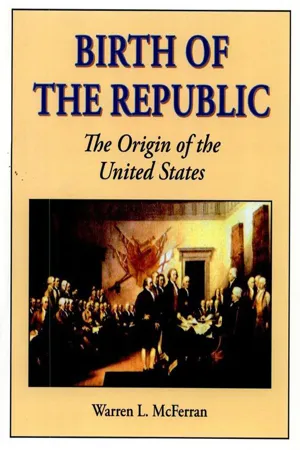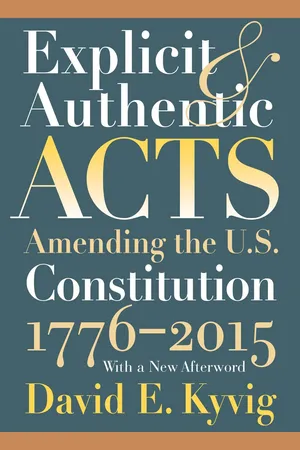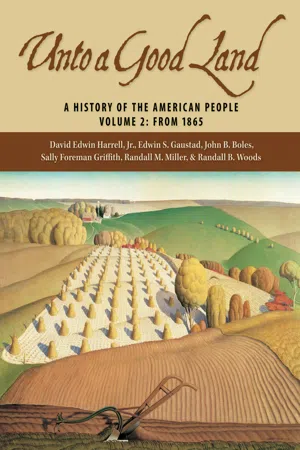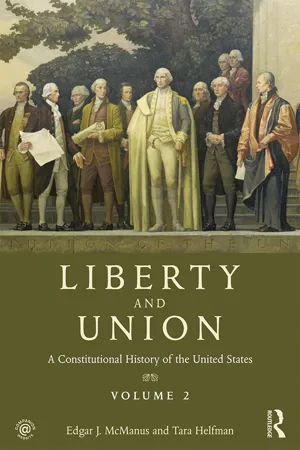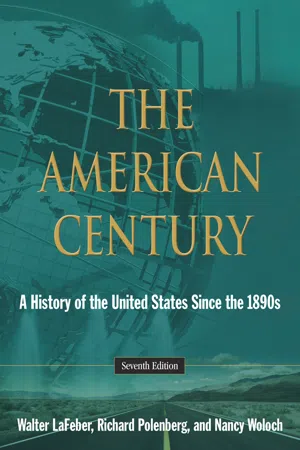History
Progressive Era Amendments
The Progressive Era Amendments refer to a series of constitutional amendments enacted in the United States during the early 20th century. These amendments aimed to address social and political issues by expanding individual rights and government regulation. The 16th Amendment allowed for a federal income tax, the 17th Amendment established the direct election of senators, and the 19th Amendment granted women the right to vote.
Written by Perlego with AI-assistance
Related key terms
5 Key excerpts on "Progressive Era Amendments"
- eBook - ePub
Birth of the Republic
The Origin of the United States
- Warren L. McFerran(Author)
- 2009(Publication Date)
- Pelican Publishing(Publisher)
It is possible, of course, that the Radical Republicans, in forcing this amendment on the States, harbored deceitful and fraudulent motives - motives that are not readily discernible from a plain reading of the Fourteenth Amendment. Even if this were true, however, it would change nothing. It is a long established principle of jurisprudence that a deception is non-enforceable and that a fraud is non-binding. If a fraud was intended, then the deception should be considered as dead as those Radicals who sought to perpetrate their ugly crime on the American people.The Progressive Era AmendmentsDuring the so-called Progressive Era of American history, four new amendments were incorporated into the Constitution of the United States. The first of these misnamed "progressive" Amendments was based on the confiscatory principles espoused in The Communist Manifesto, which advocated that a progressive income tax be utilized to confiscate the property of the more productive members of society and to facilitate the socialization of the means of production.Amendment Sixteen, often referred to as the Income Tax Amendment, was declared ratified on February 25, 1913, and is in these words: "The Congress shall have power to lay and collect taxes on incomes, from whatever source derived, without apportionment among the several States, and without regard to any census or enumeration." 64 By means of this amendment, theproperty of all Americans - except for certain key interests associated with the monied aristocracy, whose property is allowed to be shielded from confiscation by Tax Exempt Foundations - became subject to seizure on a grand scale, and the financial power of the Federal Government was allowed by grow geometrically.64Richard B. Morris, Op. at., quoted on p. 105.On May 31, 1913, Amendment Seventeen, which contains the three clauses cited below, was added to the federal compact:[1] The Senate of the United States shall be composed of two Senators from each State, elected by the people thereof, for six years; and each Senator shall have one vote. The electors in each State shall have the qualifications requisite for electors of the most numerous branch of the State legislatures. - eBook - ePub
Explicit and Authentic Acts
Amending the U.S. Constitution 1776-2015, With a New Afterword
- David E. Kyvig(Author)
- 2016(Publication Date)
- University Press of Kansas(Publisher)
10“JUST AS FAR AS PUBLIC SENTIMENT WOULD JUSTIFY’’An Era of Constitutional Activity and FaithA doption of the Sixteenth and Seventeenth Amendments in spring 1913 ignited other constitutional reform initiatives. Before the year ended separate drives were under way to obtain amendments on two long-discussed matters. Reformers’ pessimism about the capacity of the Article V process to function as the Founders intended had evaporated. After the almost simultaneous achievement of the income tax and direct election amendments, constitutional alteration no longer appeared impossibly difficult. The advantages of winning an amendment became ever more evident as Congress soon implemented a graduated income tax and a number of long-resistant states for the first time conducted popular elections for the Senate. A constitutional amendment could, in fact, produce prompt and profound change. Opponents of reform likewise began taking more seriously the prospect of constitutional alteration. As a result, the image of the Constitution as merely an antique to be admired began to fade, replaced by the vision of a workable tool ready for use.Since shortly after the Civil War, Congress had been receiving proposals for amendments to banish alcoholic beverages and to ensure women the right to vote. Not until 1913 , however, did crusades for such amendments begin in earnest. Within seven years both campaigns attained their objectives. The rapid triumph of these prohibition and suffrage quests reinforced the sense that amending the Constitution was, under certain circumstances, not only a desirable but also a realistic, achievable political goal. The adoption of four amendments, each through a separate initiative, in less than a decade thoroughly dispelled at least for the moment prior notions of an inflexible, unamendable Constitution.The prohibition and suffrage crusades affected views of the Article V process in other respects as well. The first amendments to take shape outside the national political establishment, they represented demands for government action initiated by popular constituencies rather than proposals arising within governing bodies for solutions to acknowledged problems. From Madison’s draft of a Bill of Rights in response to concerns expressed in ratification conventions to congressional responses to the need to reconstruct the Union to legislatively crafted measures to deal with tax and election problems, the governing consensus continued to spawn amendments. Grassroots public crusades to deal with perceived social problems and inequities, led by persons outside government, were hardly new, but it was unprecedented for their efforts to focus on obtaining constitutional amendments. The success of both the antialcohol and woman suffrage crusades stirred further thought as to how the public could define what it wanted its government to do or not do. - eBook - ePub
Unto a Good Land
A History of the American People, Volume 2: From 1865
- David Edwin Harrell, Edwin S. Gaustad, John B. Boles, Sally Foreman Griffith(Authors)
- 2005(Publication Date)
- Eerdmans(Publisher)
Calls for the democratization of politics led to the institution of statewide primaries in thirteen states and the legalization of women’s suffrage in nine states by 1912. In addition, twenty western states enacted initiative laws, allowing voters to force legislatures to vote on specific legislation; a similar number provided for legislation by popular referendum; and eleven states adopted a recall provision that allowed voters to force a public official to stand for reelection before his term had ended. Progressives also targeted the Senate, known as the “millionaire’s club,” for reform. Senate elections were notoriously corrupt—a late nineteenth-century aphorism asserted that “it is harder for a poor man to enter the United States Senate than for a rich man to enter Heaven.” By 1910 over half of the states required state legislators to cast their votes for Senate candidates who had won popular primary elections (known as the “Oregon system”). The Senate had successfully beaten back efforts to mandate direct elections on several occasions since the idea was first introduced in 1826, but in 1912 a Senate investigation into charges or bribery and corruption in the election of Illinois Senator William Lorimer pressured Congress into submitting to the states a constitutional amendment revising the method of selecting senators. Riding a wave of state support for reform, the Seventeenth Amendment was ratified in 1913.Although these political innovations were motivated by a kind of democratic zeal, the Progressive Era was not a time of unbridled confidence in the masses nor of expanding popular participation in politics. On the contrary, the rise of powerful interest groups with specific political agendas destroyed the broad party alliances of the nineteenth century that had politicized immigrants, the poor, and the uneducated and had raised voter turnouts to record heights. Whereas nineteenth-century urban political machines had been adept at rallying popular support, reformers’ attacks on corruption often meant reductions in voting totals and the effective disfranchisement of powerless urban groups. - eBook - ePub
Liberty and Union
A Constitutional History of the United States, volume 2
- Edgar McManus, Tara Helfman(Authors)
- 2013(Publication Date)
- Routledge(Publisher)
While progressivism brought major changes, some things hardly changed at all. The movement had almost no impact on the plight of African Americans who remained isolated and often under siege in a basically hostile society. Most southern progressives endorsed racial segregation, and northern reformers for the most part ignored issues of racial justice. The separation of the races had become one of the givens of American society, taken for granted by white reformers and conservatives alike. Woodrow Wilson presided over the final ascendancy of reform, but his administration brought Jim Crow into the federal government with a vengeance. Black workers were segregated in the Post Office Department, the Census Bureau, and the Bureau of Printing and Engraving. The Post Office and Treasury Departments downgraded or fired their black employees in the South. “There are no Government positions for Negroes in the South,” declared the Collector of Internal Revenue for Atlanta. “A Negro’s place is in the cornfield.” Despite sweeping political changes and major social reforms, progressivism brought few immediate benefits to African Americans. It left them where it found them, isolated in every way that really mattered, alone and forgotten in America’s racial cornfield.But for the rest of the country, and eventually for African Americans as well, progressivism altered the political landscape. More than a thousand state constitutional amendments were adopted, and seven states scrapped their constitutions completely and adopted new ones. Progressives led the drive for the Sixteenth and Seventeenth Amendments, and they provided momentum for the Eighteenth and Nineteenth as well. The movement spurred the beginning of a new era in federal-state relations. The proliferation of federal programs funded by the almost limitless tax base provided by the Sixteenth Amendment resulted in a vast concentration of power at the national level. As the federal government increasingly assumed responsibility for the general welfare, people with problems, blacks as well as whites, routinely looked to Washington for answers.The Supreme Court emerged from the era as the strongest branch of the federal government. It had legitimized the exercise of federal police powers but at the same time subjected their use to judicial scrutiny. Measures the Court deemed desirable were upheld; those deemed undesirable, like the Child Labor Act, were struck down on grounds that many considered specious. Its political tilt shifted with changes in personnel, but as an institution its role in government steadily grew. The Court’s jurisdiction moreover now extended far beyond the continental limits of the United States. A vast overseas empire looked to it as a court of last resort. The power of the Court certainly followed the flag even if the Constitution did not. But for the protection of fundamental rights, this may have been of more practical importance than the latter.While the Court generally took a liberal stance during the progressive years, the individual justices were not ideologically predictable. After shocking President Roosevelt by voting against the government in the Northern Securities Case, Justice Holmes handed the trust-busters a powerful weapon in his stream of commerce doctrine. None of the justices could be taken for granted on every issue. Harlan joined Fuller, Peckham, and the other economic conservatives to vote with the liberals in the Insular Cases. - eBook - ePub
The American Century
A History of the United States Since the 1890s
- Walter LaFeber, Richard Polenberg, Nancy Woloch(Authors)
- 2015(Publication Date)
- Routledge(Publisher)
HAPTER TWO 1900—1917The Progressive EraSuffragists on a picket line in front of the White House. One banner reads, "Mr. President How Long Must Women Wait For Liberty." (Library of Congress)An interest in reform has always characterized American history. What varied over time has been the things people identified as evils, the intellectual justifications and political techniques used to eradicate those evils, the obstacles reformers encountered, and the degree of support those reforms received. Seldom has a larger proportion of the population favored social improvement than during the opening years of the twentieth century, when Americans first tried in a systematic way to control the forces of industrialization and urbanization. Because the United States was becoming a major world power, the successes and failures of the Progressive movement affected not only Americans but also people around the world.The Reform Impulse
Although progressivism followed on the heels of the Populist revolt and sometimes echoed certain Populist demands, the two movements differed in important respects. Populism had drawn support primarily from farmers and had always remained a sectional force; progressivism won backing from city dwellers, including the middle classes, and had as wide a following in New York and California as in Kansas and South Carolina. Populists had sought for the most part to improve conditions in the countryside; Progressives devoted considerably more attention to political and social problems in the cities. Precisely because Progressives drew on a wider constituency and were concerned with a broader range of issues, they achieved a measure of influence at the city, state, and national levels that had eluded the Populists.Progressives did, however, pay a price for this success. So many different people wanting so many disparate things styled themselves "Progressives" that the movement often seemed to lack a clearly defined program. Progressivism attracted surprisingly diverse groups: small businessmen who favored a curb on monopolies, and big businessmen who sought to extend their economic influence and eliminate their competitors; native Americans who feared the influx of eastern European immigrants, and settlement-house workers who appreciated the newcomers' contributions to American culture; southern whites dedicated to the preservation of Jim Crow, and northern blacks just as fully committed to its eradication; social scientists who believed that planning held all the answers to human progress; and prohibitionists who imagined that closing the saloons would usher in a new world.
Index pages curate the most relevant extracts from our library of academic textbooks. They’ve been created using an in-house natural language model (NLM), each adding context and meaning to key research topics.
